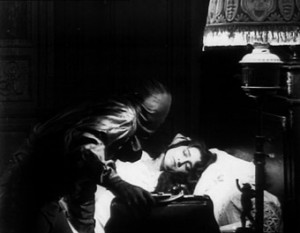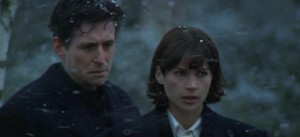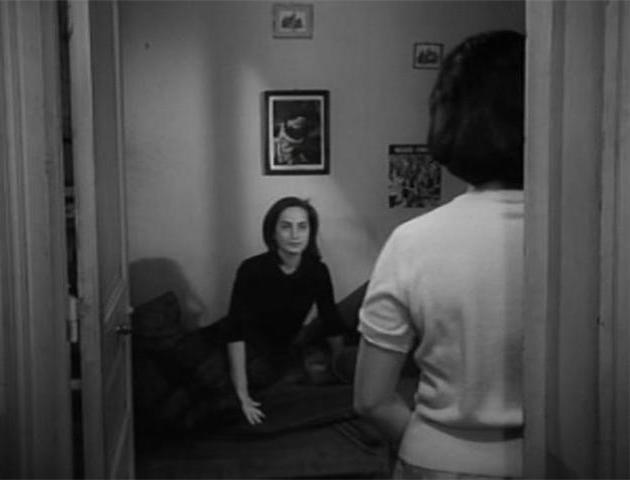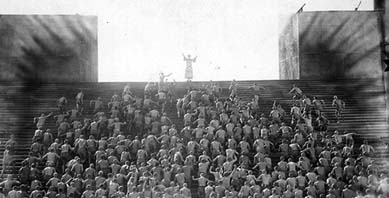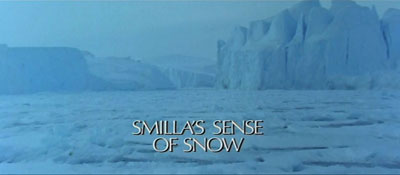From the Chicago Reader (March 14, 1997). — J.R.
Smilla’s Sense of Snow
Rating ** Worth seeing
Directed by Bille August
Written by Ann Biderman
With Julia Ormond, Gabriel Byrne, Richard Harris, Robert Loggia, Vanessa Redgrave, Jim Broadbent, Peter Capaldi, Emma Croft, and Mario Adorf.
In a couple of memorably grouchy essays published in the mid-40s, critic Edmund Wilson expounded on his impatience with detective stories, confessing that “I finally got to feel that I had to unpack large crates by swallowing the excelsior in order to find at the bottom a few bent and rusty nails.” With a few honorable exceptions, such as Kiss Me Deadly and Cutter’s Way, conspiracy films have a similar drawback: the first half is more pleasurable than the second. I suspect the reason is that the thrill of sensing a vast, invisible network behind apparent chaos is more exciting and even satisfying than the prosaic explanation, which not only reduces possibilities and halts the imagination but, by creating closure, makes the whole experience seem rather disposable.
When conspiracy thrillers resemble detective thrillers — which is often — they have a built-in advantage, to my mind, because they typically approach the borders of fantasy or science fiction and play with the ambiguous line between the real and the fantastic. The wonderful French serials made by Louis Feuillade in the teens (including Fantomas, Les vampires, Judex, and Tih Minh) and the sinister Doctor Mabuse films made by Fritz Lang in Germany in the 20s and 30s virtually invented the poetry of this form, which at its best is predicated less on neat denouements than on atmosphere and intrigue — espionage, surveillance, magical “advanced” technology, and various forms of mind control.
By the 50s, when paranoia about the atomic bomb and cold war fantasies about alien infiltration took over the conspiracy thriller, a sense of government bureaucracy became more important to the genre. In later decades this feature was succeeded by — or equated with — the influence of corporations and then multicorporations. But however well these movies conjure up the poetry of menace, they usually falter once the plot is finally unraveled. (For a classic example, watch the closing minutes of the 1965 Gregory Peck thriller Mirage.) The closer the hero or heroine comes to discovering the roots of a pervasive evil, the more pressure there is on the filmmakers to go beyond — or at least not disappoint — the viewer’s lurid imaginings. All too frequently such movies end with a ludicrous scene in which the protagonist, by virtue of discovering the truth, has to die at the hands of some hokey villain, who instead of killing him or her without delay launches into a laborious explanation of whatever the filmmakers haven’t succeeded in conveying up to this point — after which the villain perishes in some apocalyptic conflagration and the protagonist is improbably set free.
This is more or less what happens in Smilla’s Sense of Snow, a star-studded thriller set in Copenhagen and Greenland, adapted by Ann Biderman from a popular novel by Peter Hoeg and directed by Bille August. The less we know about the half-Greenlandic Inuit, half-American heroine Smilla Jaspersen (Julia Ormond) and about the death of her six-year-old neighbor, an Inuit boy from Greenland, the more gripped we’re likely to be. Similarly, the closer she comes to the truth, the more ready we are to make a beeline for the exit. The film runs for a full two hours, but it’s mostly the first hour that feels fresh and electric; after that, what feels vast — apart from some nicely filmed Greenland settings in ‘Scope — is the conspiracy-thriller machinery grinding to a stop.
Part of what’s so inviting about the first half is Ormond herself, an actress whose previous outings — in Legends of the Fall, First Knight, and Sabrina — have been more decorative than psychologically compelling (although arguably she gave Sabrina more personality than Audrey Hepburn did in 1954). Playing a reclusive Copenhagen scientist who’s never fully adjusted to life away from her native Greenland, Ormond seems a troubled, twisted individual who in some ways recalls Tippi Hedren’s neurotic characters in Hitchcock’s The Birds and Marnie (an association aided by the ersatz sub-Bernard Herrmann score of Hans Zimmer and Harry Gregson Williams, with its perpetual lack of harmonic resolution). Ormond makes the character interesting through the sheer intensity of her scattershot rage, which eventually becomes focused on the death of her young Inuit neighbor, who allegedly fell off the roof of their apartment house. Though most of the characters in her limited orbit — the bimbo girlfriend (Emma Croft) of her father (Robert Loggia) and the friendly neighbor (Gabriel Byrne) who eventually becomes Smilla’s lover — are too crudely conceived to come off as anything but generic, her abrasiveness and intensity give them a kind of promise: presumably the more we learn about her and her quest, the more interesting these other characters will become. But this promise is never fulfilled.
Turning herself into an avenging angel, Smilla is clearly bent on recovering the roots of her own Inuit identity — a process she’d begun by befriending the boy — as well as righting an obvious wrong. An enigmatic opening sequence, set in Greenland in 1859, suggests something sinister and cosmic lurks behind the mystery: an Inuit walrus hunter with his team of dogs is “chased” and crushed by a tidal wave of ice set loose by a mysterious explosion. Smilla’s marginality in Copenhagen and her quest to uncover the source of her wounded personality are both pivotal in giving this thriller its edge: the “cosmic” prologue suggests that the truth about the murder will also reveal something important about modern civilization and contemporary society as a whole, not merely her own troubled place in it. Unfortunately, the discovery and the notions of villainy it entails are strictly standard-issue.
By an interesting coincidence, Smilla’s Sense of Snow is opening the same week as a rare revival of Jacques Rivette’s first feature, Paris Belongs to Us (1960), at the Film Center. Properly speaking, Paris Belongs to Us isn’t a thriller; its characters are too scattered and diverse, its mood and pacing too funereal. But the frightening plot also features an obsessive quest revolving around a global conspiracy, and its mysterious poetry is explicitly linked to such cinematic forerunners as early Fritz Lang (not only Mabuse but Metropolis) and Kiss Me Deadly. Compared to a slick production like Smilla’s Sense of Snow, Rivette’s modernist tale about Parisian bohemians, artists, and theater people in the late 50s is strictly amateur night — shot piecemeal over a couple of years with a cast of relative nobodies, produced by Rivette’s then unknown colleagues Claude Chabrol and Francois Truffaut, and featuring cameos by Rivette himself, Chabrol, Jean-Luc Godard, and Jacques Demy. But the picture has so many striking parallels to Smilla’s Sense of Snow — and so much to say about its own period and milieu — that it’s a useful point of comparison. The quest of a student named Anne (Betty Schneider) for a tape of “apocalyptic” guitar music recorded by a Spanish emigre who may have committed suicide is paralleled by Smilla’s search for an audiocassette that “explains” the conspiracy she’s trying to uncover, and each woman’s quest for self-definition is eventually folded into a project to uncover a global conspiracy.
Even more important, Paris Belongs to Us, the first feature of a film critic, offers a critical and philosophical commentary on the conspiracy thriller itself — a fascinating account of its allures and its dangers. In fact, Rivette’s principal point about conspiracy theories is that they are alluring, to the audience as well as the characters. The satisfactions of coherence they offer are so compelling that even the potential or apparent victims of such conspiracies can’t resist imagining them (a paranoid vision with ties to Kafka). But rather than simply prove his characters’ conspiracy theories to be pure and simple hallucinations, Rivette performs the far more difficult task of keeping us perpetually uncertain about them: now we see them, now we don’t. In fact we can never be certain whether they exist or not because our need for them is so palpable.
In Rivette’s greatest work — the 750-minute serial Out 1: Noli me tangere (1970) and the 255-minute Out 1: Spectre (1972) he carved out of it — he turned this uncertainty into a formal principle, knotting together strands of conspiracy and narrative connection in the first half of each work, then systematically untying them in the second. An almost identical strategy is at work in the 1973 novel Gravity’s Rainbow, a postmodernist work by the other great contemporary master of conspiracy fantasies, Thomas Pynchon, who has explored similar themes in V, The Crying of Lot 49, and Vineland (and whose latest novel, Mason & Dixon, is due out next month). The fact that Rivette and Pynchon arrived at the same artistic formula independently, on separate continents, at roughly the same time points to a profound shared historical experience — the shattering of the 60s counterculture’s utopian dreams. A motto for both works might be taken from one of the narrator’s musings in Gravity’s Rainbow: “If there is something comforting — religious, if you want — about paranoia, there is still also anti-paranoia, where nothing is connected to anything, a condition not many of us can bear for long.”
Central to this vision is the image of whiteness — the fusion of all the colors in the rainbow into nihilistic certainty. This image can be traced all the way back to the blaze of light (read: nuclear holocaust) pouring out of a mythical Pandora’s box at the apocalyptic climax of the 1955 Kiss Me Deadly. The same terminal whiteness figures many times in Paris Belongs to Us — in an empty canvas splashed by a drink in an early party scene (in response to a statement about apocalypse), in the flight of swans over a placid lake in the eerie closing sequence, and in a blank movie screen (the concluding image of Gravity’s Rainbow) after a screening of the Tower of Babel sequence from Lang’s Metropolis. (The Tower of Babel itself, with its notion of colliding languages, might be said to correspond to the “white light” of all the colors in the rainbow, again yielding the terrifying specter of “anti-paranoia, where nothing is connected to anything.”)
For this reason, there’s something inherently satisfying about the way Smilla’s Sense of Snow culminates in Greenland’s vast, icy reaches, expanses of white stretching in all directions, an image that’s planted even by the film’s title. But in contrast to the modernist Paris Belongs to Us and Out 1 and the postmodernist Gravity’s Rainbow, this film is resolutely premodernist in all of its assumptions. It’s a generic thriller moving without ambiguity toward an explanatory payoff, but without the sense of its own place in history that would have given that payoff a clarifying resonance. What we get instead is as outlandish and cornball as the payoff in a James Bond thriller — or a Feuillade serial with SF trimmings but without the poetry or the ambiguity that might justify all the heavy breathing of the quest itself. By the end Smilla has become a formulaic action hero — equally at home in an evening dress and blue jeans — not a marginalized victim seeking to uncover the source of her wound, and the film collapses around her like glaciers of melting ice.



